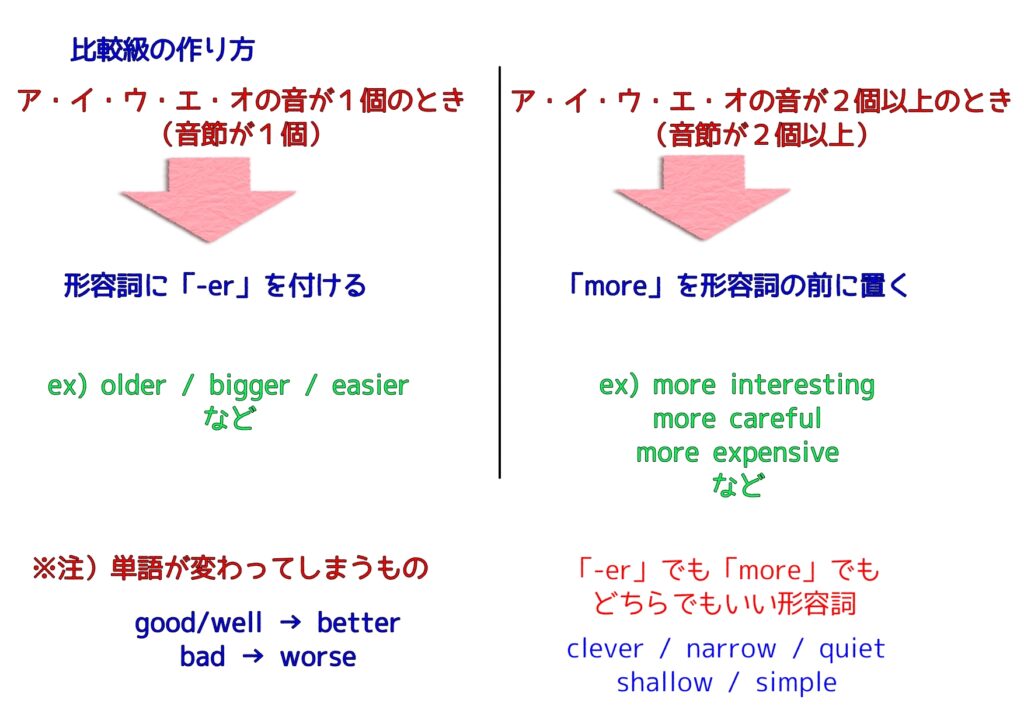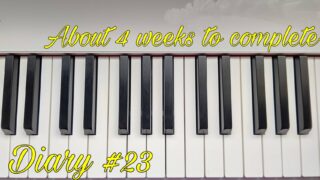第72回:比較表現を活用する(発展編)

比較表現にも様々ありますが、より応用的な表現について確認を進めてみましょう。
Q. この記事で、一番大事なことって何?
A. 大事なことを、1枚の画像にまとめました。

いちいちノートにまとめるのが面倒だという方、また、
ノートにまとめることが苦手だという方は、ご活用ください。

[広告]
確かな英語力は、日々の継続から。
その継続を後押しする、第二言語習得理論に基づいた
オンライン英語学習プログラムがあります。
英語を使う人のための、確実なスキルアップが望める
7日間の無料体験はこちらから!

形容詞と副詞の比較級と最上級の形
形容詞や副詞の比較級を作る方法や、最上級の形について詳しく説明します。
比較級: -er vs more / less… than
一音節の形容詞や副詞には通常、比較級形を作るために「-er」を追加します。ただし、以下の場合は「more + 形容詞」の形を使用します。
- 一音節の過去分詞形容詞(例: bored, creased, pleased, worn)には「more + 形容詞」を使用します。「After I’d ironed my shirt it looked more creased than before.」(シャツをアイロンでかけた後、以前よりもしわがより目立った。)のように表現します。
- fun, real, right, wrongとの比較では、「more wrong」など「-er」を使用せず、「more + 形容詞」の形を使用します。「I expected the film to be rather dull, but I couldn’t have been more wrong.」(私はその映画がかなり退屈だと思っていたが、私は完全に間違っていた。)
- 二つの質を比較する場合にも「more + 形容詞」を使用します。「Wasn’t he brave to swim across?」(彼は泳いで渡るのに勇敢だったね?)「I think he was more mad than brave.」(私は彼が勇敢よりもむしろ狂気じみていたと思う。)といった表現があります。
- 「Although the paint was called ‘Sky Blue’, I thought it was more green than blue.」(その塗料は「スカイブルー」と呼ばれていましたが、私はそれが青よりもむしろ緑色に近いと思いました。)というように、「… so much brave as mad」という表現や、「… blue rather than green」といった形も使用できます。
また、比較を強調するために、「more」を「-er」の代わりに使用することもあります。「You might think it’s dark here but it’s more dark in the cellar.」(ここは暗いと思うかもしれませんが、地下室の方がもっと暗いです。)のように表現します。
二音節の形容詞と「more / less」の使用
二音節の形容詞の多くは、「more / less」を使って比較級を表します。特に以下のような形容詞に頻繁に使用されます。
- 分詞形容詞(例: worried, boring)
- 「-ful」と「-less」で終わる形容詞(例: careful, careless)
- afraid, alert, alike, alone, ashamed, aware
- その他の形容詞(例: active, cautious, certain, complex, direct, eager, exact, formal, frequent, modern, special, recent)
また、二音節の形容詞のうち、「-y」、「-ow」、「-er」、「-ure」で終わる形容詞は、比較級を「-er」または「more + 形容詞」の形で表すことができます。ただし、「-er」の形がより頻繁に使用されます。また、complete, equal, favorite, ideal, perfect, uniqueといった形容詞は比較級や最上級の意味を持つため、「-er」や「more / less」、「-est」や「most / least」という形であまり使用されません。ただし、特別な強調をするために比較級や最上級の形を使用することもあります。「The weather today was good, but less perfect than yesterday.」(今日の天気は良かったですが、昨日ほど完璧ではありませんでした。)といった例です。
最上級
最上級の形容詞や副詞の前には通常、「the」、所有形(-‘s)、または所有代名詞を使用します。非公式な文脈では、「the」を省略することもありますが、特に文の末尾での「-est」や「most + 形容詞」の形については、「the」を省略することがあります。「’Why did you go by bus?’ ‘It was (the) cheapest.’」(「なぜバスで行ったのですか?」 「一番安かったからです。」)や、「Which was (the) most expensive?」(「一番高かったのはどれでしたか?」)といった表現です。ただし、何を比較しているかを述べる場合には、「the」を省略することはできません。「’Why did you buy these oranges?’ ‘They were the cheapest ones I could find.’」(「なぜこれらのオレンジを買ったのですか?」 「それらは私が見つけられた中で一番安いものでした。」)といった例です。
「most + 形容詞/副詞」は、「the」をつけずに使用されることもありますが、その場合は「most」は「very」のような意味になります。「I checked the form most carefully but didn’t notice the mistake.」(私はその用紙を非常に注意深くチェックしましたが、ミスに気づきませんでした。)
最上級の後には「of + 複数名詞句」を使用します。
最上級を表す際には、「of + 複数名詞句」を使用して、比較されている対象を明示します。「Adam’s the oldest of my three brothers.」(アダムは私の三人の兄弟の中で一番年上です。)といった表現が一般的です。また、「of」を前置詞として使用することで、強調をすることもできます。「Of my three brothers, Adam’s the oldest.」(私の三人の兄弟の中で、アダムが一番年上です。)といった例です。
比較が行われている場所や文脈を示す場合には、「in + 単数名詞句」を使用することが一般的です。「It was the tallest tree in the forest.」(それは森で一番高い木でした。)のように表現します。(「the tallest tree of the forest」ではなく、「the tallest tree in the forest」とします。)
形容詞と副詞の比較級と最上級の形は、英語で比較や強調をする際に重要な役割を果たします。適切に使いこなすことで、より正確で効果的な表現ができるでしょう。
具体例
- Comparatives:
- One-syllable adjectives: tall → taller, fast → faster
- One-syllable past participle adjectives: bored → more bored, pleased → more pleased
- Fun, real, right, wrong: The party was more fun than I expected.
- Comparing two qualities: He was more mad than brave.
- Emphasizing the comparison: The room was more dark than I had imagined.
- Examples of other adjectives: clear → clearer, cold → colder, deep → deeper
- Two-syllable adjectives:
- Participle adjectives: worried → more worried, boring → more boring
- Adjectives ending in -ful and -less: careful → more careful, careless → more careless
- Other examples: complex → more complex, frequent → more frequent
- Superlatives:
- Using the before a superlative: It was the longest movie I’ve ever seen.
- Leaving out the before an -est or most + adjective superlative in informal contexts: It was (the) brightest.
- Giving the group of things being compared: These apples are the juiciest ones.
- Emphasizing the of-phrase: Of all the options, this is the most expensive.
- Superlatives with location/context:
- Using in + singular noun phrase: She is the tallest student in the class.
Additional examples:
- The coffee at this café is more delicious than at any other place.
- John’s car is the fastest in our neighborhood.
- Among all the participants, she was the most talented.
- Of all the books on the shelf, this one is the oldest.
- In the city, this skyscraper is the tallest building.
[広告]
TOEICのスコアを上げたいけれど、
まとまった勉強時間が取れなくて困っている…
なら、細かいスキマの時間を使いながら、
少しずつスキルを積み重ねてみてはどうでしょう。
スマホ1つでスコアアップが出来る、
オンライン講座のリンクはこちらから。

Q. この文法はどうやって使うのでしょうか?
A. 今回の文法を活用した会話文を見てみましょう。

Have you seen the new painting in the gallery? It’s absolutely stunning!
(ギャラリーの新しい絵、見た?本当に素晴らしいんだよ!)

Oh, really? I heard it was quite good, but I didn’t expect it to be that impressive.
(え、本当に?いいって聞いたけど、そこまで感動的な作品だとは聞いて無かったよ。)

Trust me, it’s more impressive than you can imagine. The artist’s attention to detail is amazing.
(これはホント。想像以上に感動的なんだ。アーティストの細部への注意がすごいんだよ。)

I might have to go and see it for myself then. Is it more colorful than the other paintings?
(じゃあ、自分で見に行かなきゃ。他の絵よりもカラフルなの?)

Yes, definitely. It’s the most colorful piece in the entire exhibition. The vibrant hues make it stand out.
(そうだよ、間違いなく展示会で一番カラフルな作品だ。鮮やかな色彩が際立っているんだ。)

That’s intriguing. I’m really curious now. Which room is it displayed in?
(それは興味深いね。今、すごく気になってきたよ。どの部屋に展示されているの?)

It’s in the main hall. You can’t miss it. It’s the biggest painting in there.
(メインホールにあるよ。行ったら分かると思う。そこには一番大きな絵が飾られているんだ。)

Ah, I think I know which one you’re talking about. It’s the one with the striking composition, right?
(ああ、どの絵のことを言ってるのか分かったよ。構図が印象的な作品だよね?)

Exactly! It’s the most creatively composed artwork in the entire collection.
(まさにその作品だよ!コレクション全体で一番創造的に構成された作品なんだ。)

I can’t wait to see it. Thanks for letting me know. I’ll make sure to visit the gallery soon.
(早く見たくなったな。教えてくれてありがとう。ギャラリーには近いうちに行くよ。)
[広告]
ロゼッタストーン・ラーニングセンターで、最先端の教育制度を活用して英語を学びませんか?私たちは個々の学習ペースに合わせてeラーニングと対面教育を組み合わせ、柔軟な学習環境を提供しています。自宅でのeラーニングと対面教育のメリットを最大限に活かし、あなたの英語学習をサポートします。最新のテクノロジーと個別の指導が組み合わさった当センターで、自由な学習スタイルを体験してみませんか?英語学習を楽しく効果的に進めるための環境がここにあります。新たな一歩を踏み出して、新しい英語学習の旅に参加しましょう!

Q. この記事の要点は?
A. 比較表現の確認をしました。
Adjectives and adverbs: Comparative and superlative forms
- Comparatives:
- One-syllable adjectives and adverbs: Add -er to form the comparative.
- One-syllable past participle adjectives: Use more + adjective.
- Fun, real, right, and wrong: Use more + adjective.
- Comparing two qualities: Use more + adjective… than.
- Emphasizing the comparison: Use more + adjective (alternative to -er form).
- Some specific adjectives can take either -er or more form.
- Two-syllable adjectives:
- Participle adjectives, -ful, -less adjectives, and certain other adjectives: Use more / less.
- Most two-syllable adjectives ending in -y, -ow, -er, and -ure can take -er or more form.
- Superlatives:
- Use the, a possessive form, or a possessive pronoun before a superlative adjective or adverb.
- The can sometimes be omitted in informal contexts.
- Use of + plural noun phrase to name the objects being compared.
- Use in + singular noun phrase to indicate the location or context of the comparison.
英会話を始めてみたいけれど、どのサービスが良いか分からない…
そんな方は、まず、この記事で3つのサービスを比べてみてはいかがでしょうか?
英語力を効率良く伸ばすことができるサービス3選です。

次回の文法解説は?
更に、比較表現を確認する。
この記事を作る際に参考にした文法の解説書になります。
すべて英語で書かれていますが、練習問題が付いてます。
イギリス英語なので、スペル等の表記が異なる部分もありますが、
「使い方を練習したい」「繰り返し問題を解きたい」
という方は、使ってみても良いかもしれません。

関連記事一覧
他の文法解説記事を検索できます。



-320x180.jpg)
-320x180.jpg)


-1-320x180.jpg)





コメント